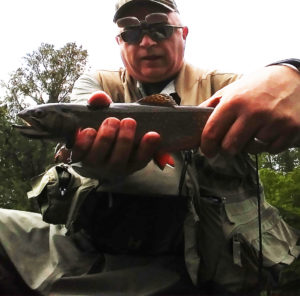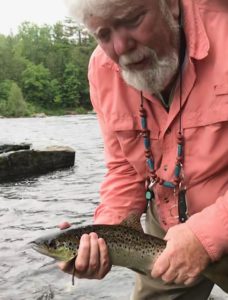Recently, a couple of fishing buddies and I traveled to East Millinocket, ME to do some fly fishing in the West Branch of the Penobscot River. This is a large wild river in upper Maine that is noted for its large wild brook trout and landlocked salmon. In addition to myself, there were Ron Wojcik of Windsor, Paul Knauth of Hinsdale and Attorney Michael Shepard of Dalton, MA. It is an 8-hour drive from the Berkshires, so we stopped at Cabelas in Scarborough, ME approximately half way, to rest and pick up a few fishing supplies.
We rented a cabin on Twin Pines NE Outdoor Center on Millinocket Lake in East Millinocket. Each day we drove approximately one-half hour along the Golden Road, the primary road access to the river, to get to an area below Ripogenus Falls where we knew some nice fish were awaiting us.
Ripogenus Falls once controlled discharge from Ripogenus Lake until Ripogenus Dam, (92 feet high and 704 feet wide) was completed at the upstream end of the Ripogenus Gorge in 1916. The dam forms a hydroelectric reservoir raising the level of Ripogenus Lake to include the upstream Chesuncook Lake, Caribou Lake, and Moose Pond. Hydroelectricity is generated by diverting water 2,400 cu ft/s through a mile-long penstock around the former falls.
The West Branch once had river log drives transporting pulpwood to a lumber mill in Millinocket. They began in 1917 and the last one was in 1928. Environmental concerns ended river transport of pulpwood in 1971 when the Great Northern Paper Co. opened the above mentioned Golden Road. Since then the lumber industry has been greatly diminished and the Millinocket mill is being torn down.
We left home around 5am and arrived at our cabin around 2pm, ate a sandwich and, although a little tired, we were off to the river by 4pm or so. We were concerned about the forecast of rain for the next 2 days, so at least we could get some decent weather to fish on the day of arrival. Once at the river, we realized that in our tired condition and haste, Paul left his rod at the cabin, Ron left his reel there and I forgot my flip down spectacles. Nice start, hey? No problem, we usually take two rods and reels so a little bit of lending and everyone went to the stream fully equipped, except for my spectacles.
They were releasing 2,400 cfs of water which made the river level just about perfect for fishermen as well as the commercial rafters and kayakers.
The fishing was outstanding with many brookies and landlocks caught and released. We left the river earlier because even though we brought food to cook up in the cabin, we were too tired to cook and decided to eat at a restaurant in the complex where we were staying. The only problem was that it closes at 9pm and we had a half hour ride to get back. We did make it in time.
The weather forecast of rain for the next day was wrong and we had a pleasant and fruitful day, catching lots of cooperative fish. But this time we stopped fishing around 3pm, drove back to that restaurant and ate when it opened at 4pm. Then back to the river and we fished until total darkness, sometime after 9pm. That was when Ron landed the largest brook trout of the trip, one estimated to be around 18 inches. He caught it on a gray caddisfly in some pretty heavy current.
The next morning, the rain continued to hold off and it was another beautiful day. That was when Mike connected with the largest fish of the trip, a landlock salmon estimated to be 20 inches. He caught it on a Stimulator (a fly which imitates an adult stonefly).
Once again, we knocked off around 2pm, went back to the cabin and this time had an early dinner of spaghetti and chicken/sausage prepared by Mike. After gorging ourselves, three of us went out fishing again. (Paul’s back was giving him some trouble so he stayed at the cabin, cleaning it up so that we could get an early start for home the following morning).
The fishing was slower that evening, although Ron caught several nice landlocks and brookies. Just as we left the river in darkness, it started to rain and rained all night.
It was a beautiful trip shared by good friends. We all caught and released lots of nice fish. Of course, the biggest fish didn’t wait to be released, but decided to release themselves, usually taking our flies with them. Those are smart and scrappy fish up there. Once hooked, the landlocks frequently jump 3 feet out of the water and they no sooner come down and they are airborne again. They are masters at tangling around submerged rocks and cutting your leaders. If you use a heavy leader, the fish won’t touch your fly, and if you use a thinner leader, they will take your fly, but usually break you off. It’s a Catch 22 situation, but very enjoyable.
It is a tough river to wade. Three of the four of us took spills; I went down twice but Mike had the most spectacular. Ron nearly injured his shoulder with his fall, but none of us got seriously banged up.
One day, we came across Tom Fuller and his wife Pat on the stream. Tom is a fellow member of the New England Outdoor Writer’s Association who wrote several excellent fly fishing books including: Getting Started in Fly Fishing, The Complete Guide to Eastern Hatches, Trout Streams of Southern New England and Underwater flies for trout. We had a nice chat on the riverbank.
At night, we sat around the cabin table having a drink and munching on baked goodies that our spouses baked and sent along with us. Our conversations covered everything from the day’s fishing, to troubles with kids today, to the Donald, etc.
The most successful flies were adult and emerging caddisflies, size #16, such as Henryville Specials, Elk Hair Caddis, other caddisfly emergers, Blue Winged Olive mayflies and the Stimulator stone fly. Paul tied up and shared an emerger fly of which the fish couldn’t get enough. I’ll bet he could have charged $20 apiece for it.
But a fishing trip to Maine isn’t all about catching fish. We enjoyed the company of two bald eagles that perched on trees directly across the river from us. At one time, a gull swam by with a fish in its bill. That prompted the eagles to try to take it away, swooping at the gull until it dropped the fish. For the next several minutes, both eagles and the gull flew around us looking for that fish in the waters but they weren’t successful.
While on the Golden Road, we frequently observed a mother moose with her young. In the early mornings, we would hear and observe loons paddling along on the quiet lake where we were staying, as we enjoyed views of Mount Katahdin.
Aah, fly fishing with good friends on the Penobscot……it doesn’t get much better.
Berkshire Outdoorsman
Hunting and fishing in the Berkshires, MA
